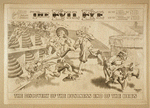"All around that door green vines were growing out of the grassy bank, and they were full of flowers. Red and blue and purple and rosy-pink and white and striped flowers all had their throats wide open as if they were singing glory to the monring. They were morning-glory flowers.
Laura went under those singing flowers into the dugout. It was one room, all white. The earth walls had been smoothed and white-washed. The earth floor was smooth and hard.
When Ma and Mary stood in the doorway the light went dim. There was a small greased-paper window beside the door. But the wall was so thick that the light from the window stayed near the window.
That front wall was built of sod. Mr. Hanson had dug out his house, and then he had cut long strips of prairie sod and laid them on top of one another, to make the front wall. It was a good, thick wall with not one crack in it. No cold could get through that wall.
....The ceiling was made of hay. Willow boughs had been laid across and their branches woven together, but here and there the hay that had been spread on them showed through...
They all went up the path and stood on the roof of that house. No one could have guessed it was a roof. Grass grew on it and waved in the wind just like all the grasses along the creek bank.
'Goodness,' said Ma. 'Anybody could walk over this house and never know it's here.'
But Laura spied something. She bent over and parted the grasses with her hands, and then she cried. 'I've found the stovepipe hole! Look, Mary, Look!'
Ma and Mary stopped to look, and Carried leaned out from Ma's arm and looked, and Jack came pushing to look. They could look right down into the whitewashed room under the grass."
---Laura Ingalls Wilder, "The House in the Ground," in On the Banks of Plum Creek
Today's entry features a dark and hidden house built under morning glories. Nearly all of the homes featured in Wilder's series are idealized in some way as evidence of the family's industry, innovation, thrift, creativity, love of beauty, and order. The books certainly espouse a very particular political stance--especially considering the date of their publication if not the date of their setting. Yet there is a narrative of loss that underwrites every volume. These losses, I suspect, are only visible to the adult reader.
Sunday, April 4, 2010
Subscribe to:
Post Comments (Atom)






No comments:
Post a Comment